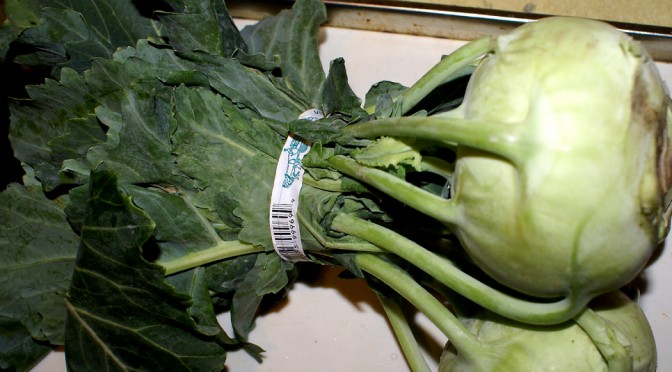Kohlrabi is one of my favorite vegetables. I didn’t “discover” it until a few years ago when one of my friends in France mentioned it to me as a potato alternative. As luck would have it, my local grocery had some in stock so I tried it. Whenever I’m looking for an option to replace potatoes in a recipe, I try it two or three ways I would cook a potato, the first being to fry it. Kohlrabi handled this marvelously, frying up nicely into a tasty plank that doesn’t taste like potato, but still gives you an excellent fried vegetable with sandwiches. It also handled the roast and boil test as well as being a great sliced vegetable in salads.
America is just now finding kohlrabi, it seems, although it’s been here since the early 1800’s. I mostly hear that people have cut it thinly or shredded it and used it in their salads or that they’ve used the leaves and thrown the bulb away or fed it to farm animals . But it is so much more. I love to mix it with cauliflower and celery root and make mashed veggies with it that can replace mashed potatoes. They don’t taste like mashed potatoes, but they have such a wonderful flavor that I don’t even care. As a side dish on its own, cooked with butter and seasonings, it is delicious. I cannot rave enough about this vegetable!
History
This is a relatively new vegetable that originated in Germany. The name is German for cabbage (kohl) and turnip (rabi). Indeed, the vegetable comes from the same root family as cabbage, cauliflower, kale and Brussels sprouts — the wild mustard plant. Prior to about 500 years ago, there was no record or indication of either kohlrabi or Brussels sprouts. They appear to be cultivated varieties of the root stock. What is unusual about kohlrabi is that the vegetable grows into a round tuber on the stalk with long stalks of leaves coming out it. It’s almost like having a root above ground. While it looks odd, its flavor is similar to its cousin broccoli’s stalk, but milder in flavor. The leaves are also edible, although by the time the bulb reaches 3 inches or more in diameter, the leaves get a little tough. They can be cooked and used as you would turnip or mustard greens.
There are several varieties of kohlrabi, the green variety being seen most often. There is also a purple variety. I have grown some of each in my garden and I notice the purple variety tends to be more elongated. They like cool weather though and thus far, I haven’t gotten them to maturity before summer sets in.
The vegetable needs to be peeled as there are two layers of tough skin and fiber that are not edible. I find it easiest to parboil them for about three minutes, cool them down, then a paring knife removes these layers quickly. I really urge you to try kohlrabi, raw or cooked, and enjoy this marvelous-tasting vegetable.
Recipes
Here’s a few recipes from Skinny Girl that use or feature kohlrabi:
Spicy Chicken Kohlrabi Curry
Hungarian Style Kohlrabi Rolls
Kohlrabi and Ham Casserole
Irish Style Celery and Kohlrabi
Broccoli with Mornay Sauce
Nutrition information for 1 cup (135 g) kohlrabi
Calories: 36.5 Fat: 0.1 g Net Carbs: 3.5 g Protein: 2.3 g
All comments relevant to my posts are welcome. SPAM is not. If the post has nothing to do with my site content, it will not be posted.
References for this article include Wikipedia, Specialty Produce, Kohlrabi and Brussels Sprouts Are European
Photos taken by R. Averett, copyright Skinny Girl Bistro



Had my first kohlrabi tonight. Simply sliced and steamed with butter. Delicious!
I’m not sure this is what I think it is. My aunts sometimes graw a kind of turnip that is big and round and pale, but when it arrives to me usually it’s already sliced, so I’m not sure it’s the same vegetable.
My mum used to add it to soups for flavour
That could be one of several possibilities. Kohlrabi has a slightly greenish shade to it and it is almost the texture of a raw apple or a peeled broccoli stem. A rutabaga is a slightly yellowish flesh inside and it is also big and round. There are several turnips that might fit the bill. Do you know if the vegetable developed above ground? I think kohlrabi is the only one of the ones I mentioned that form on the stalk. Did you eat it cooked or raw?
How do you find all these things? Must be a great adventure to discover new foods!
-Mee (The Chinese Quest)